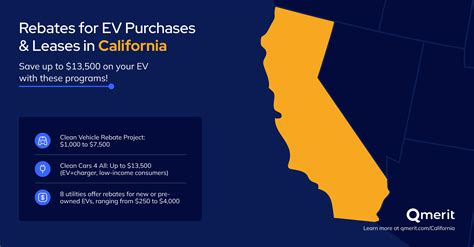Power Up: How California’s EV Charger Rebates are Energizing Green Initiatives
In the race towards sustainability, California has proven to be a trailblazer by incentivizing the adoption of electric vehicles (EVs). Among the state’s initiatives, the EV charger rebate program stands out as a crucial component. These rebates are designed to encourage the installation of EV charging stations, thus supporting the widespread usage of electric vehicles. As California aims for a significant reduction in greenhouse gas emissions, these rebates play a vital role in energizing green initiatives across the state.
The Importance of EV Charging Infrastructure
The transition to electric vehicles is heavily dependent on the availability of robust charging infrastructure. Unlike conventional vehicles that rely on gasoline stations, EVs require a network of charging points to facilitate seamless travel. Without sufficient charging stations, potential EV owners might hesitate to make the switch due to concerns about range anxiety.
California’s commitment to increasing the number of EV charging stations is evident through its rebate initiatives. By lowering installation costs for charging stations at homes, businesses, and public spaces, the state aims to create a supportive environment for EV use. This not only encourages individuals to purchase electric vehicles but also advances the overall goal of reducing carbon emissions.
How the Rebate Program Works
The California Electric Vehicle Infrastructure Project (CALeVIP) provides financial incentives for the installation of EV charging stations. The amount of rebate varies depending on the type of charger and its location. For instance, residential installations can receive rebates of up to $800, while commercial installations may qualify for larger sums.
To access these rebates, applicants must install approved equipment and meet certain eligibility criteria. The process typically involves submitting an online application along with documentation proving the charger’s installation. By simplifying the application process and providing substantial financial support, California makes it easier for residents and businesses to invest in EV infrastructure.
Environmental and Economic Benefits
California’s EV charger rebates offer various environmental and economic advantages. Firstly, they help reduce greenhouse gas emissions by promoting the use of electric vehicles, which are known to produce fewer emissions than their gasoline counterparts. According to the California Air Resources Board, the transition to EVs can significantly lower the state’s carbon footprint, contributing to cleaner air and a healthier environment.
Moreover, the adoption of EV charger installations creates numerous jobs within the clean energy sector. As demand for charging infrastructure increases, jobs related to manufacturing, installation, and maintenance of EV chargers will also rise, ultimately benefiting the economy. This dual focus on environmental and economic benefits underscores California’s comprehensive approach to sustainability.
Challenges and Considerations
Despite the clear benefits, California’s EV charger rebate program is not without its challenges. For one, the initial costs and logistics involved in installing charging stations can deter some potential applicants, particularly in underserved communities. Ensuring equitable access to these programs is essential for maximizing their impact.
Furthermore, as more charging stations are installed, the state must simultaneously manage the electrical grid’s demand. With increased charging needs, there may be a risk of grid congestion during peak hours. To address this, California is investing in grid improvements that can accommodate the growing number of EVs without compromising energy reliability.
The Future of EV Charger Rebates in California
The future of California’s EV charger rebate program is promising as the state continues to push for ambitious environmental goals. Plans to expand rebate offerings and increase the number of public charging stations are already underway. By 2030, California aims to have 1.5 million zero-emission vehicles on the road, a surprising leap from the current figures.
Moreover, legislative measures are being proposed to further incentivize businesses and multifamily housing complexes to install charging stations, ensuring that all Californians have equal access to EV infrastructure. This trajectory will likely result in even greater adoption of electric vehicles while simultaneously providing environmental benefits.
Conclusion
California’s EV charger rebate program is a vital step forward in the fight against climate change and the transition toward a sustainable future. By incentivizing the installation of EV charging stations, the state is lowering financial barriers and addressing range anxiety—two significant hurdles to widespread EV adoption. The economic and environmental advantages of this initiative cannot be overstated, positioning California not only as a leader in electric vehicle adoption but also as a model for other states looking to boost green initiatives. As residents and businesses alike embrace electric vehicles, the future looks bright for sustainability in California.
FAQs
1. Who is eligible for the EV charger rebate in California?
Eligibility varies depending on the type of charger installation. Generally, both residential and commercial properties can apply, but specific criteria must be met. Applicants typically need to install approved charging equipment and submit necessary documentation.
2. How much can I receive from the EV charger rebate?
Rebate amounts differ based on the installation type and location. Residential installations can receive up to $800, while commercial installations may qualify for higher amounts. It’s advisable to check the CALeVIP website for specific details regarding rates.
3. What kinds of chargers are eligible for the rebate?
California’s EV charger rebate typically covers Level 2 chargers and certain DC fast chargers. Always confirm the eligibility of the specific hardware with official program documentation.
4. How do I apply for the rebate?
Applicants can submit an online application through the CALeVIP website after completing their charger installation. The application process includes uploading required documentation such as installation proofs and charger specifications.
5. Will there be more rebates introduced in the future?
Yes, California plans to expand its EV charger rebate program and introduce more incentives to encourage participation, particularly focusing on underserved communities and businesses. Keep an eye on legislative updates for the latest information.
Download Ev Charger Rebate California
